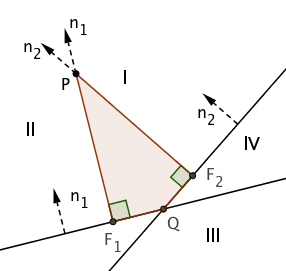Prove that for $c,r>0$,
if $\langle a,b\rangle\cdot\langle p,q\rangle=ap+bq>0$ then the bisector of the obtuse angle is $\dfrac{ax+by+c}{\sqrt{a^2+b^2}}=\dfrac{px+qy+r}{\sqrt{p^2+q^2}}$
if $\langle a,b\rangle\cdot\langle p,q\rangle=ap+bq<0$ then the bisector of the acute angle is $\dfrac{ax+by+c}{\sqrt{a^2+b^2}}=-\dfrac{px+qy+r}{\sqrt{p^2+q^2}}$
What I knw
$<a,b>$ is one of the vector perpendicular to the line $ax+by+c=0$ and $<p,q>$ is one vector perpendicular to the line $px+qy+r=0$.
If the signed distance is positive, the normal vector points from the line towards the point, while a negative value means that the normal points away from the point. The two intersecting lines divide the 2d plane into four halfplanes say $L^+_1,L^+_2,L_1^-,L^-_2$ depending on the sign of $ax+by+c$ and $px+qy+r$. One of the angle bisectors will go through the regions $L_1^+,L_2^+$ and $L_1^-,L_2^-$, in which both the normals are either pointing away or towards the points. Thus we can draw the quadrilateral as shown by @amd.
And, if the angle between normals is acute, ie. $n_1.n_2=-n_1.-n_2> 0 $ then the angle between line and bisector is obtuse. ie. the obtuse angle bisector is $\dfrac{ax+by+c}{\sqrt{a^2+b^2}}=\dfrac{px+qy+r}{\sqrt{p^2+q^2}}$.
if the angle between normals is obtuse, ie. $n_1.n_2=-n_1.-n_2< 0 $ then the angle between line and bisector is acute. ie. the acute angle bisector is $\dfrac{ax+by+c}{\sqrt{a^2+b^2}}=-\dfrac{px+qy+r}{\sqrt{p^2+q^2}}$.
This is clear !!! Except,
Doubt
I think in order to find the obtuse and acute angle bisector we need to choose the normals of the lines both pointing either towards the point or away from the point. And may be that is where the condition $c,r>0$ or $c,r<0$ comes in. It'd be helpful if someone could clarify this ?
Note
I have gone through a similar post,answer by @amd, How do I prove this method of determining the sign for acute or obtuse angle bisector in the angle bisector formula works?, which tries to prove this condition but the part that involves my doubt is confusing for me.
